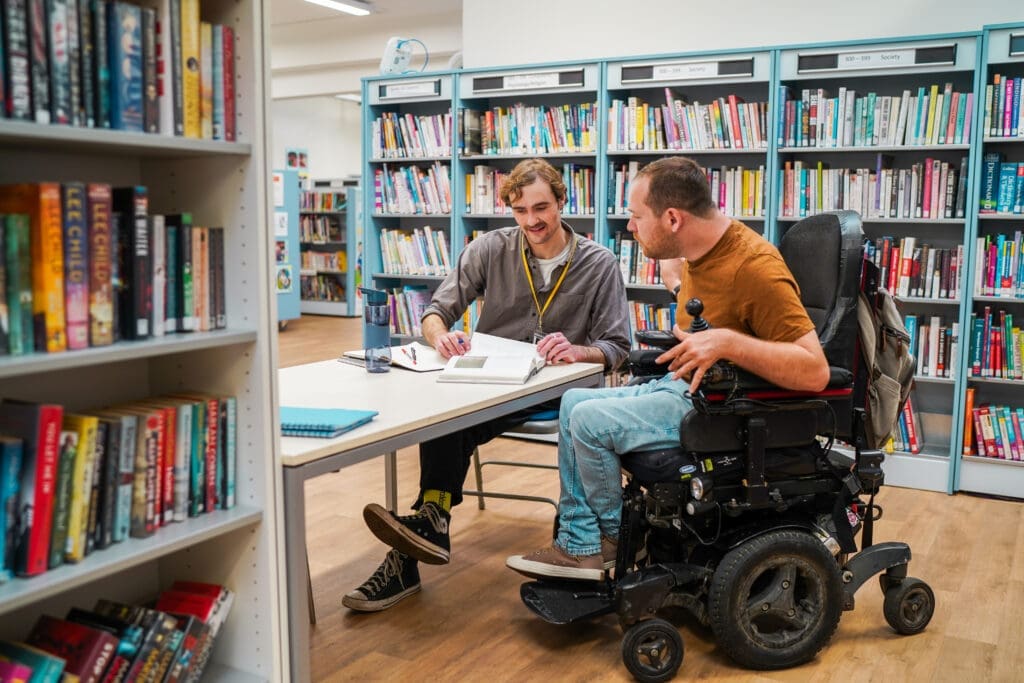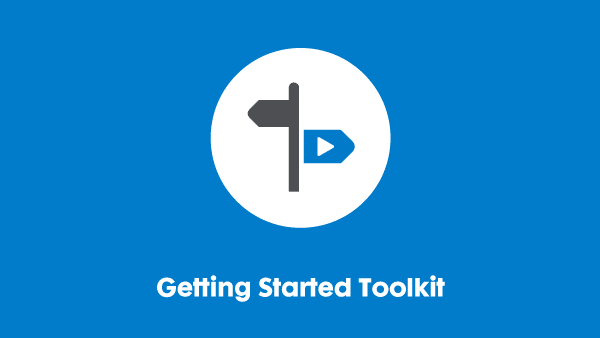Last updated: 14 November 2025
Factsheet – Cerebral palsy

This resource is part of our Disability Essentials range. You can find the other free resources that are included in this range by clicking here.
What is cerebral palsy?
Cerebral palsy is the name for a group of conditions that affect a person’s mobility and co-ordination. It occurs before, during, or shortly after birth and may result from trauma, infection, lack of oxygen or stroke. It may take up to two to three years to be aware of any signs and symptoms of cerebral palsy.
There are four main types of cerebral palsy:
- Spastic cerebral palsy– the muscles are stiff and tight (especially when trying to move them quickly), making it difficult to move and reducing the range of movement that’s possible.
- Dyskinetic cerebral palsy– the muscles switch between stiffness and floppiness, causing random, uncontrolled body movements or spasms.
- Ataxic cerebral palsy– when a person has balance and co-ordination problems, resulting in shaky or clumsy movements and sometimes tremors.
- Mixed cerebral palsy– when a person has symptoms of more than one type of cerebral palsy.
Other terminology associated with cerebral palsy include:
- Hemiplegia – indicates that one side of the body is affected.
- Monoplegia – one limb is affected.
- Diplegia – two limbs are affected.
- Quadriplegia – all limbs and often the whole body is affected.
Podcast – ‘If you don’t mind me asking…’ with Heather Lacey
In this episode, Lucy and Dan are joined by activist, writer, researcher and public speaker Heather Lacey who talks about her experiences with cerebral palsy, chronic pain, fatigue and mobility issues: “Disabled people are not going away… we are at least one in five of your workforces, and we need to make sure that there’s always things progressing and changing and there’s room for improvement… and we need to continue to keep this at the very top of the agenda,” says Heather.
You can connect with Heather here: Linkedin and Twitter.
How does cerebral palsy affect an individual?
Cerebral palsy can affect people in many different ways and degrees of severity. Some people have very mild symptoms that may not be immediately apparent to many people, whereas others can be more severely affected. The main symptoms include:
- the limbs and body appear too stiff or floppy
- weakness in the arms or legs
- fidgety, jerky or clumsy movements
- random, uncontrolled movements
- vision problems such as reduced vision or uncontrollable eye movements
- hearing loss
- difficulty with speaking
- difficulty with eating, swallowing and prone to drooling
- digestive system problems such as reflux
- learning challenges
- seizures
- increased likelihood of depression.
The condition is not progressive, but it can put increased strain on the body, causing pain, especially in the joints as the person ages.
Potential impact on work and customers
The impact on work will depend on the nature of the job and the severity of any symptoms. Some people will not require any adjustments, whereas others with more severe and complex disabilities will need more.
Customers and visitors to your business who have cerebral palsy may require adjustments depending on their needs. This might be access for walking aids or wheelchairs. It may also include fully accessible toilets and training for staff awareness of cerebral palsy.
Legal duties
The Equality Act 2010
In the UK, employers have duties to:
- prevent discrimination, and
- provide reasonable adjustments
for their disabled employees. This means that it is unlawful for employers to treat applicants, job candidates and employees unfavourably because of their disability.
The Equality Act also requires employers to make ‘reasonable adjustments’ for their disabled employees.

Suggested adjustments
A person with cerebral palsy has lived with the condition all their life and already has an excellent idea of what adjustments they need. Some common examples include those below.
Accessing, using and leaving premises
Accessing, using, and leaving buildings can be difficult for many people with conditions affecting mobility. Building regulations, and health and safety legislation try to mitigate these where possible, but some will remain.
- Once inside the building, accessible lifts may be required. These should be easily accessible for people who use walking aids and wheelchair users. Some electric wheelchairs are large, especially if there are extra bags and equipment attached. Handrails may also be beneficial in some key areas.
- Ensure walkways are kept clear and are wide enough for them to navigate with any aids they are using.
- Doors can be very heavy and should ideally have an accessible opening such as a push-button activations system. The position of swipe card opening systems should enable wheelchair users to access them easily.
- Emergency egress must be considered for all staff and visitors. If a person’s cerebral palsy is affecting their mobility, balance, vision or hearing, a Personal Emergency Evacuation Plan (PEEP) should be put in place. This may be as simple as having a ‘buddy’ to help them safely leave the building or having a refuge area with a planned exit procedure in place.
Workstation
- It may be appropriate to move the employee’s workstation to make it easier for them to navigate to their desk or accessible toilet facilities.
- Ensure that there is room for them to keep any equipment safely and comfortably at their workstation.
- A workstation ergonomics assessment should be carried out as required by the regulations. This includes a reassessment every time there are significant changes to a person’s health or workplace, or role. It should involve assessing access to their desk and everything they need to do their job. The assessment should also consider the need to buy specialist software or hardware, including dictation software, larger screens and magnifiers, lighting, keyboards and mice. The individual will likely know what software, hardware and equipment works best for them.
Travel
- If the person is travelling for work, the weight of laptops and related equipment may need to be considered. For example, a trolley bag may be easier than a backpack. Access to Work may carry out specialist workplace assessments and provide financial assistance with some adjustments.
- Business travel can be tiring and bring additional challenges for someone with cerebral palsy. Adjustments may include allowing extra daytime travel to and from sites, especially for long-distance and overseas travel. All overseas travel should include a travel risk assessment and should be completed early for anyone with cerebral palsy to implement any adjustments. This might be arranging travel to a hotel or booking an accessible room, or airport or train assistance. The app, Access Able, can help with this.
Working with the rest of the team
Other employees may not initially feel comfortable around a new member of the team who has cerebral palsy. This is usually due to fear of doing or saying the ‘wrong thing’.
They may also have concerns about how best to communicate, especially if it is difficult to understand what is said. Giving the new employee with cerebral palsy an opportunity to meet team members in a less formal setting before starting work may resolve many of these concerns.
Whilst most people will quite quickly ‘tune in’ to the way someone they are working with speaks, this may cause some initial anxiety. It may be helpful to offer colleagues some simple guidance on communication and etiquette, for example:
- Give the person with cerebral palsy time to say what they want to; someone with cerebral palsy may speak more slowly. Don’t interrupt or finish sentences for them.
- Be honest – don’t pretend to understand if you do not. Don’t be afraid to ask someone to repeat or rephrase what they just said.
- If meetings are usually animated or in a noisy area, make sure you allow the employee the opportunity to express themselves. Communication can be more difficult if there is a lot of background noise.
- If someone takes longer to communicate, allow more time for meetings to make sure they are not rushed.
- In some cases, someone with cerebral palsy may not be able to speak at all. Do not assume that this is indicative of cognitive impairment. They may use a speech-generating device or prefer to communicate in writing.
- Some people with cerebral palsy may be less comfortable using the telephone, particularly to someone they have not spoken to before. Do not assume that this is the case, but if they prefer to communicate by email or text (for example), they should be allowed to do so. This may involve an adjustment of duties such as arranging for other team members to take more calls from the public while the disabled employee handles written communication.”
Further information
For more information on suggested adjustments, specific barriers for cerebral palsy and information about the law, please see our other resources in the Knowledge Hub.
Advice Service
For more detailed information and advice about a specific situation, contact the Advice Service:
Telephone: +44-20-7403-3020
Textphone: +44-20-7403-0040
Email: advice@businessdisabilityforum.org.uk
Scope
Web: www.scope.org.uk
Tel: 0808 800 3333
Email: helpline@scope.org.uk
If you require this content in a different format, contact enquiries@businessdisabilityforum.org.uk.
© This resource and the information contained therein are subject to copyright and remain the property of the Business Disability Forum. They are for reference only and must not be copied or distributed without prior permission.

